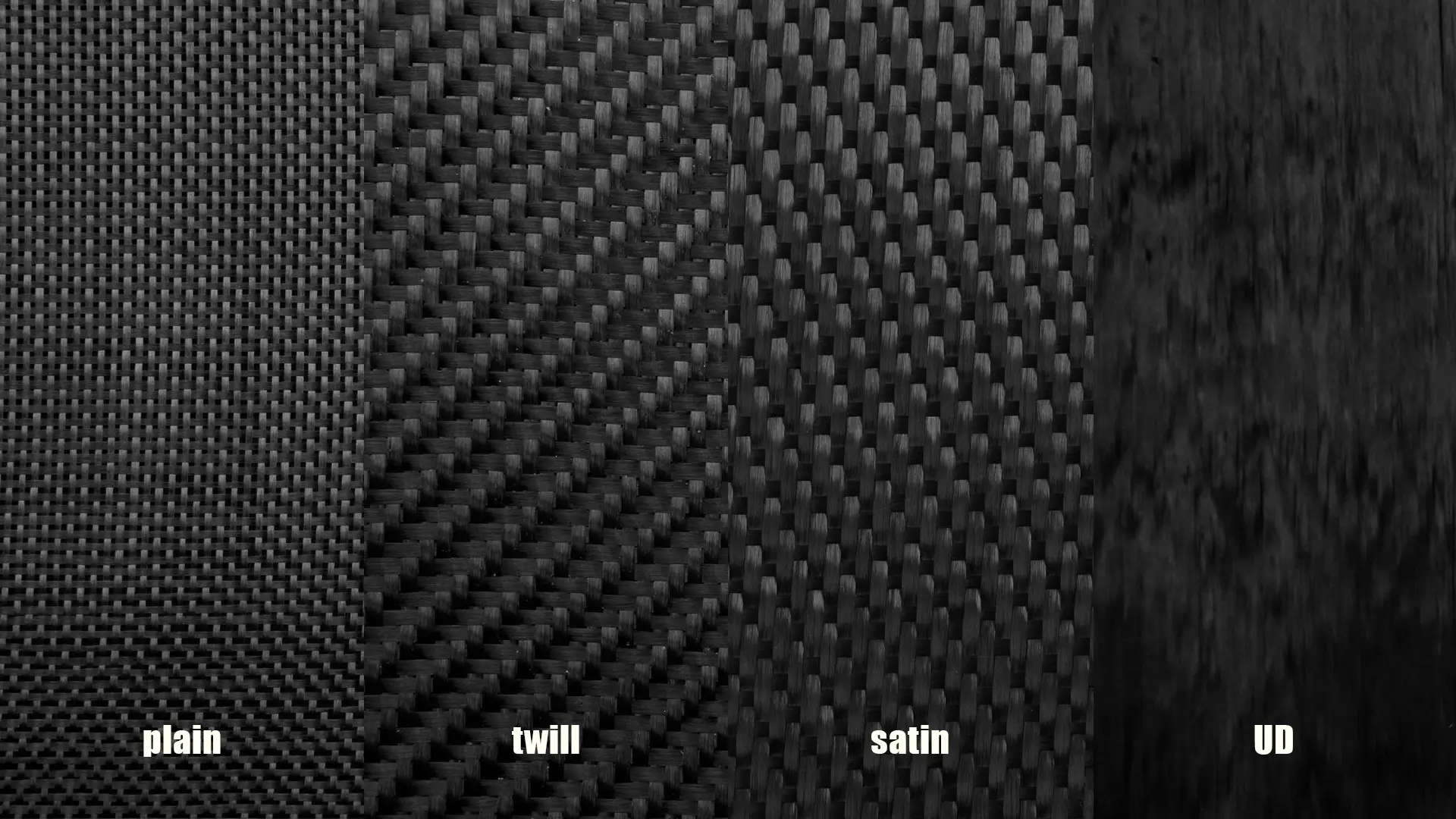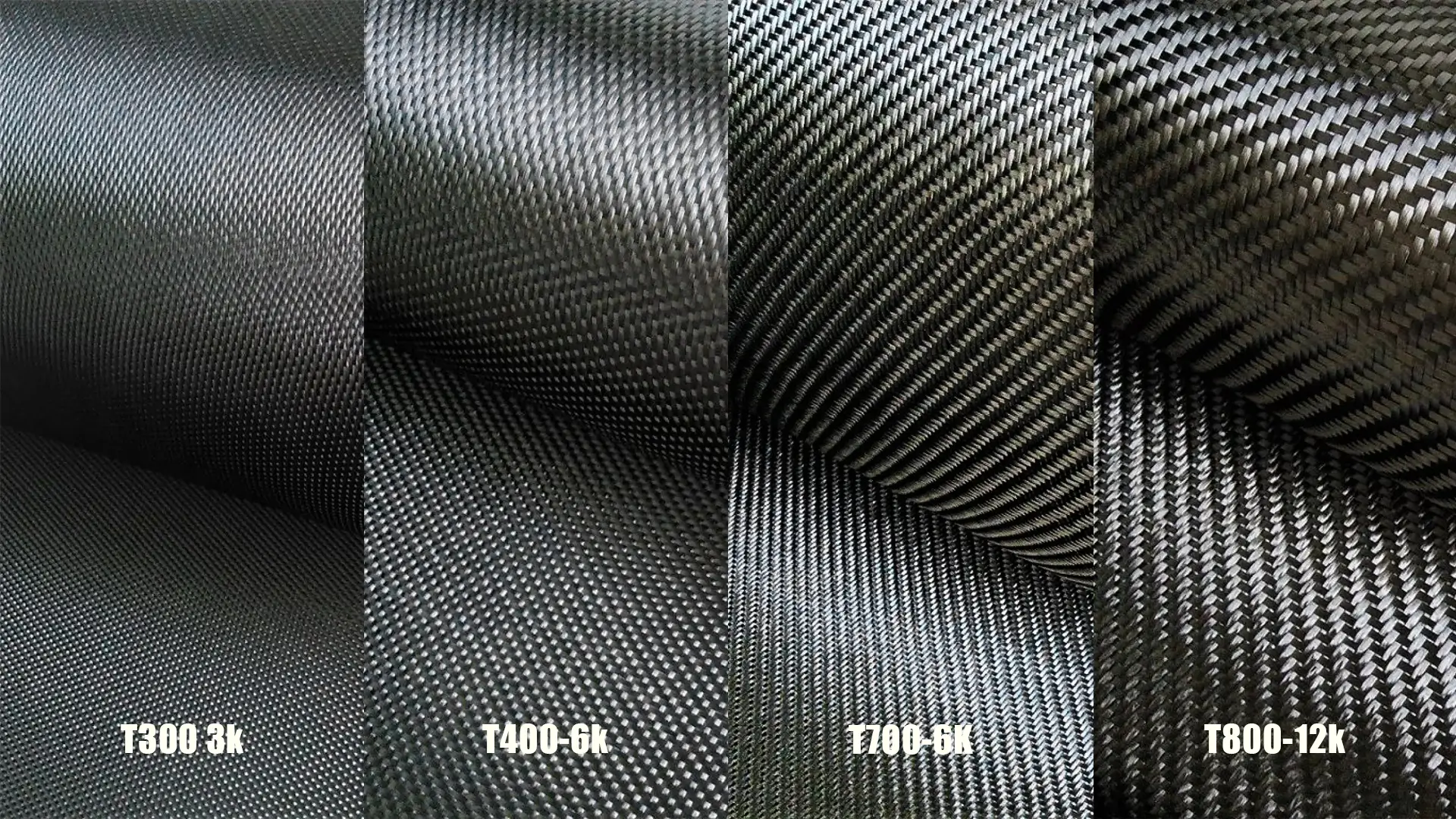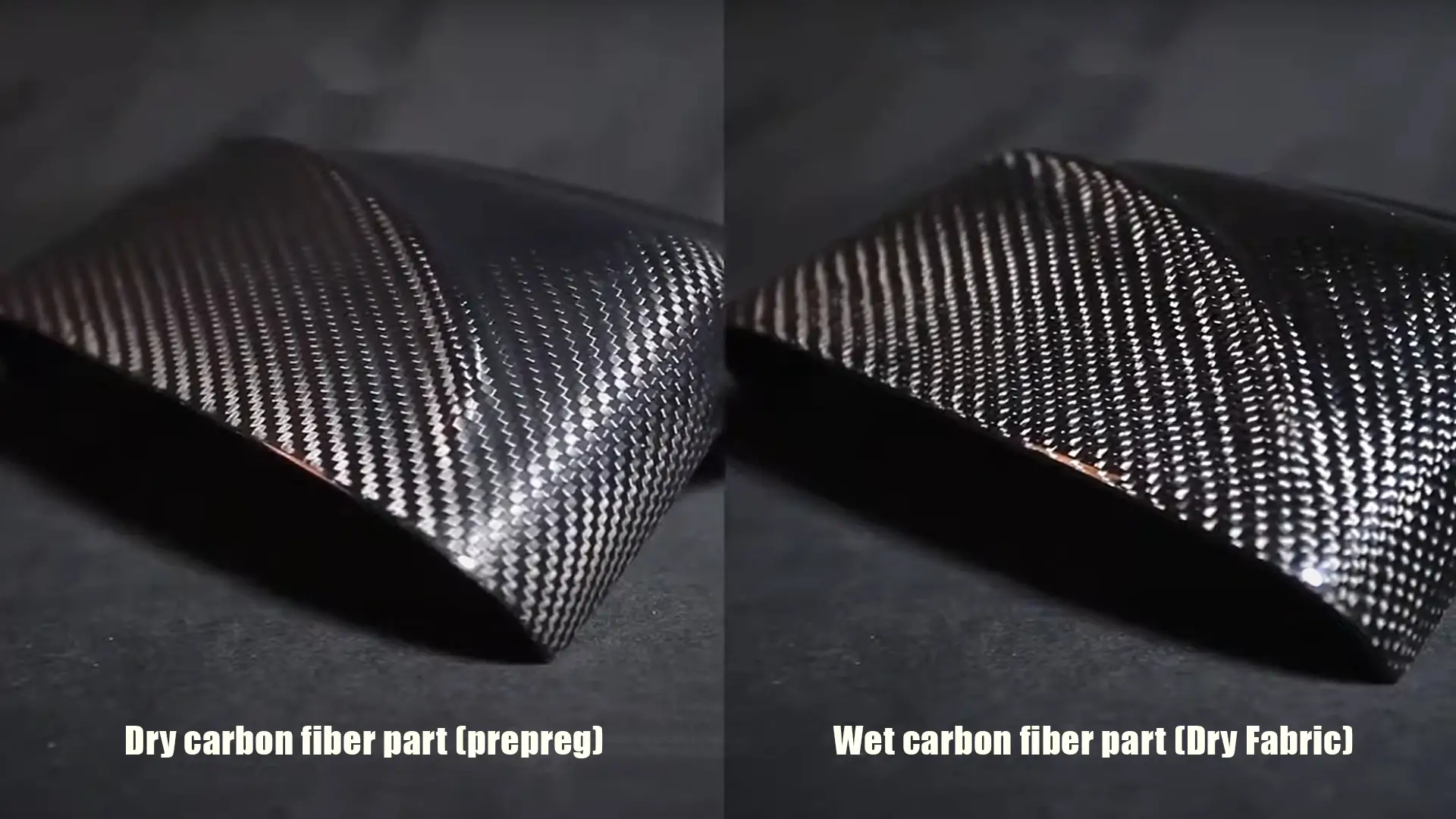Common Carbon Fiber Weave Types Overview
| Weave Type | Structural Characteristics | Advantages | Common Applications |
|---|---|---|---|
| Plain Weave | 1×1 interlacing (over-under) | Even strength, high stability | Structural parts, core layers, bottom layers |
| Twill Weave | 2×2 / 4×4 diagonal interlacing | Soft, easy to lay, attractive look | Automotive body parts, exterior parts |
| Satin Weave | Large interlacing gaps, glossy surface | Smooth surface, high-end appearance | High-end exterior, bicycles, artworks |
| Basket Weave | Multiple fibers interlacing in groups | Good stability, strong decorative appeal | Structural reinforcement layers, decorative parts |
| Spread Tow Fabric | Flat, wide fibers arranged neatly | Extremely lightweight, clear texture | High-end visual parts, racing, bicycles |
| UD (Unidirectional) | All fibers aligned in one direction | High strength, directional enhancement | Structural reinforcement (pulling direction) |
| Biaxial (+45°/-45°) | Fibers interlaced in two directions (+45° / -45°) | Multi-directional reinforcement, shear resistance | Wind turbine blades, panel structures |
| Triaxial | 0°/±60° or 0°/±45° | Balanced strength in all directions | Aerospace, military structural parts |
| Multiaxial (NCF) | Multiple directional layers (non-woven) | Large area reinforcement, lightweight | Hulls, wings, large structural parts |
| Braided Fabric | Fibers cross and wrap around to form cylindrical shapes | Suitable for tubular or complex parts | Pipes, irregular-shaped structures |
| Knitted Fabric | Non-traditional fiber interlacing, fibers looped | Stretchable, good flexibility | Flexible parts, apparel-grade carbon fabric |
| Hybrid Weave | Carbon fiber + Kevlar / fiberglass | Combines multiple properties | Bulletproof, impact-resistant parts |
Plain Weave Carbon Fiber
Custom plain weave carbon fiber consists of tows woven over and under one another in an alternating pattern. Each tow passes over one and under one in a symmetrical grid. This creates a checkerboard-like surface texture.
Plain weave is tight and flat, offering stability and dimensional accuracy. It resists fraying and distortion, making it ideal for flat surfaces or geometries with fewer curves.

Twill Weave Carbon Fiber
Custom twill weave carbon fiber has a diagonal pattern, where each tow passes over two or more threads and under one or more. The result is a more flexible fabric with a smoother, more dynamic appearance.
Twill weaves are more visually appealing and are often used for parts where aesthetics are important, such as car hoods, bike frames, or interior trim.
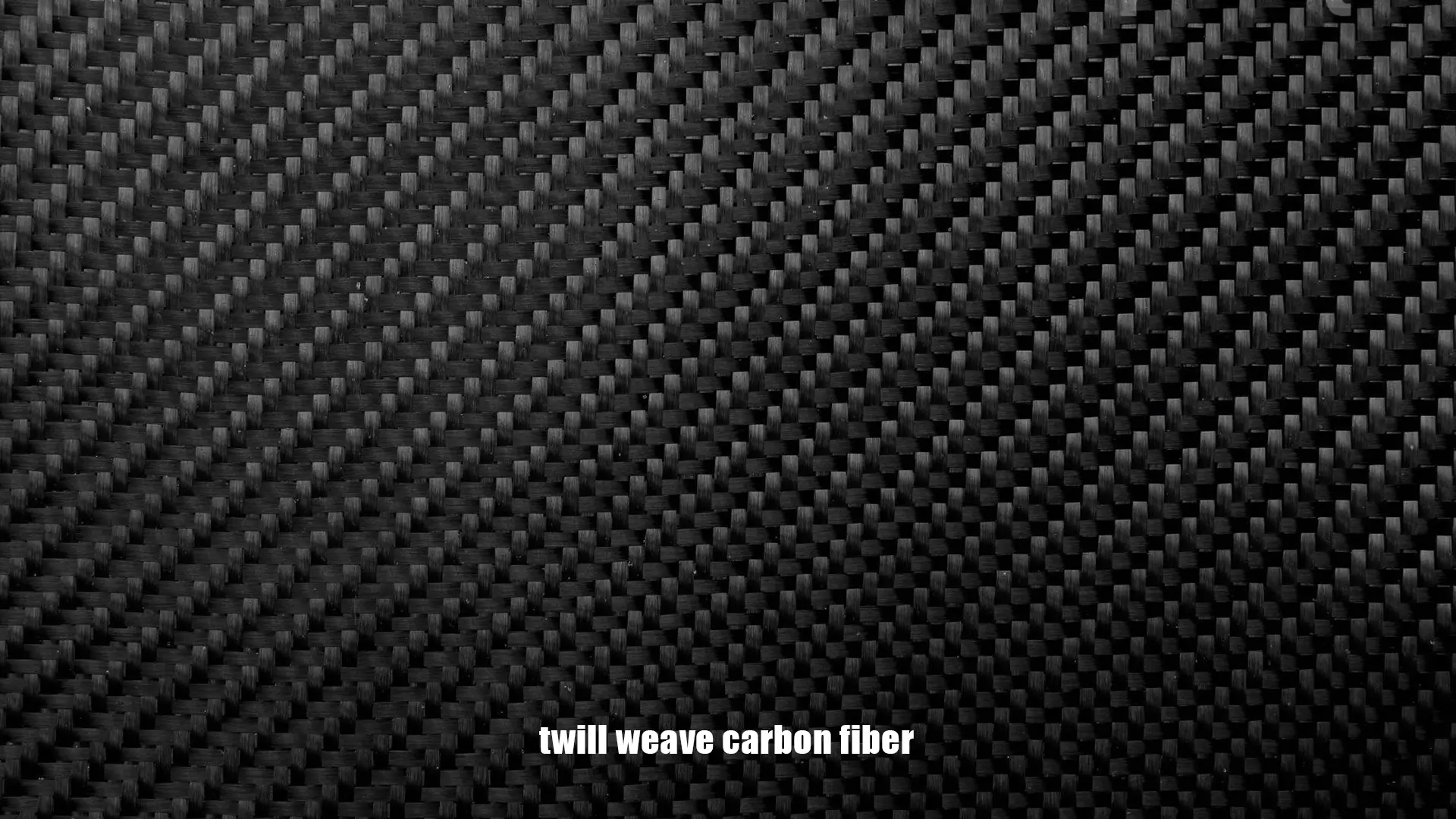
Satin Weave Carbon Fiber
Custom satin weave carbon fiber is a type of weave that strikes a balance between twill and plain weaves. It features a smooth surface with a subtle sheen and fewer crossover points, typically found in 4-harness or 5-harness patterns. In this structure, the fiber tows pass over several others before going under one, creating a softer and more flexible fabric that is easier to drape over complex shapes.
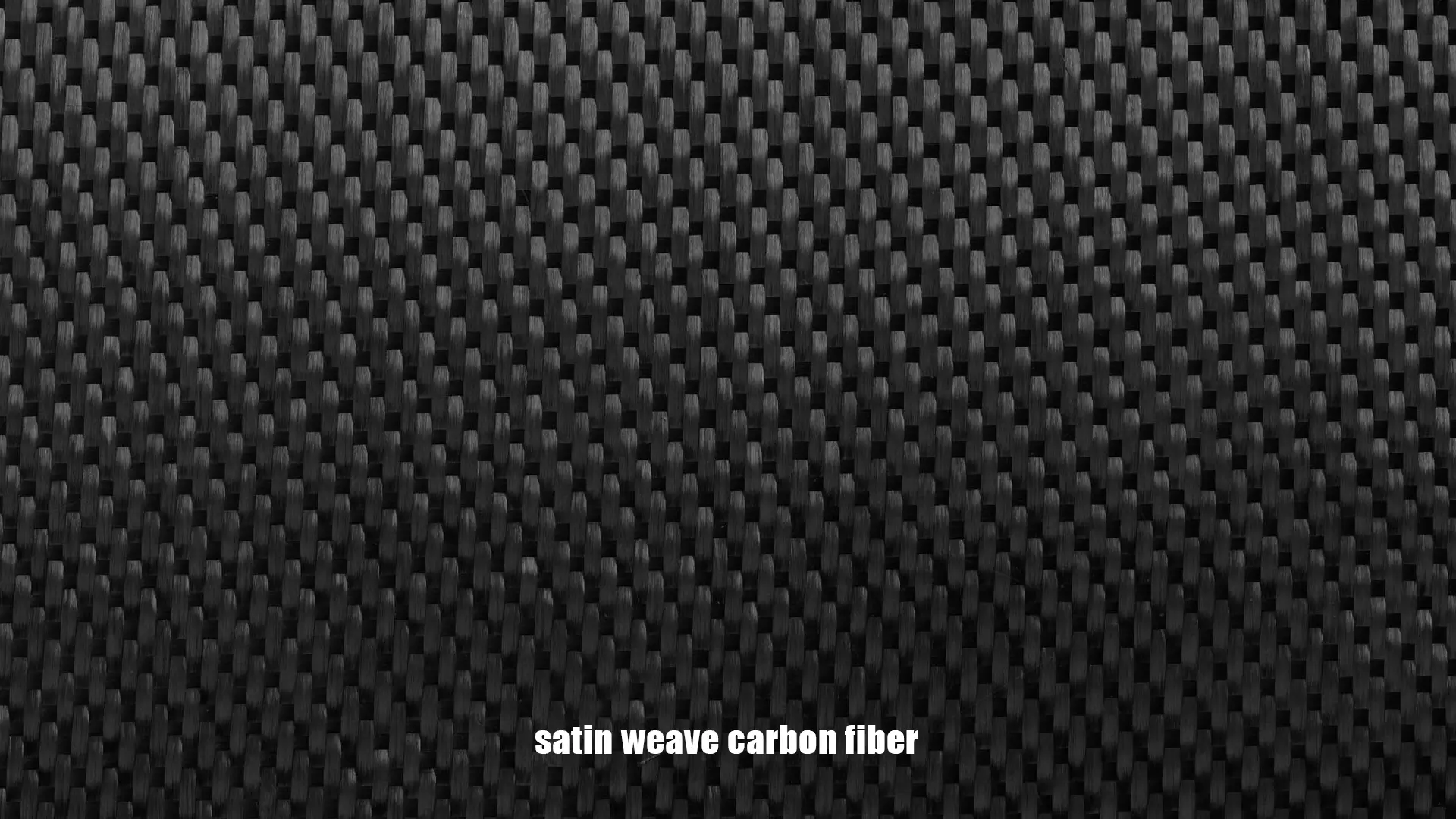
Unidirectional (UD) Carbon Fiber
Custom unidirectional carbon fiber, often referred to as UD, consists of carbon fibers aligned in a single direction with minimal or no weaving. The fibers are held together by a binder or backing material, allowing for precise control of strength in one direction. This makes UD carbon fiber extremely strong and stiff along the fiber axis, but much weaker perpendicular to it.
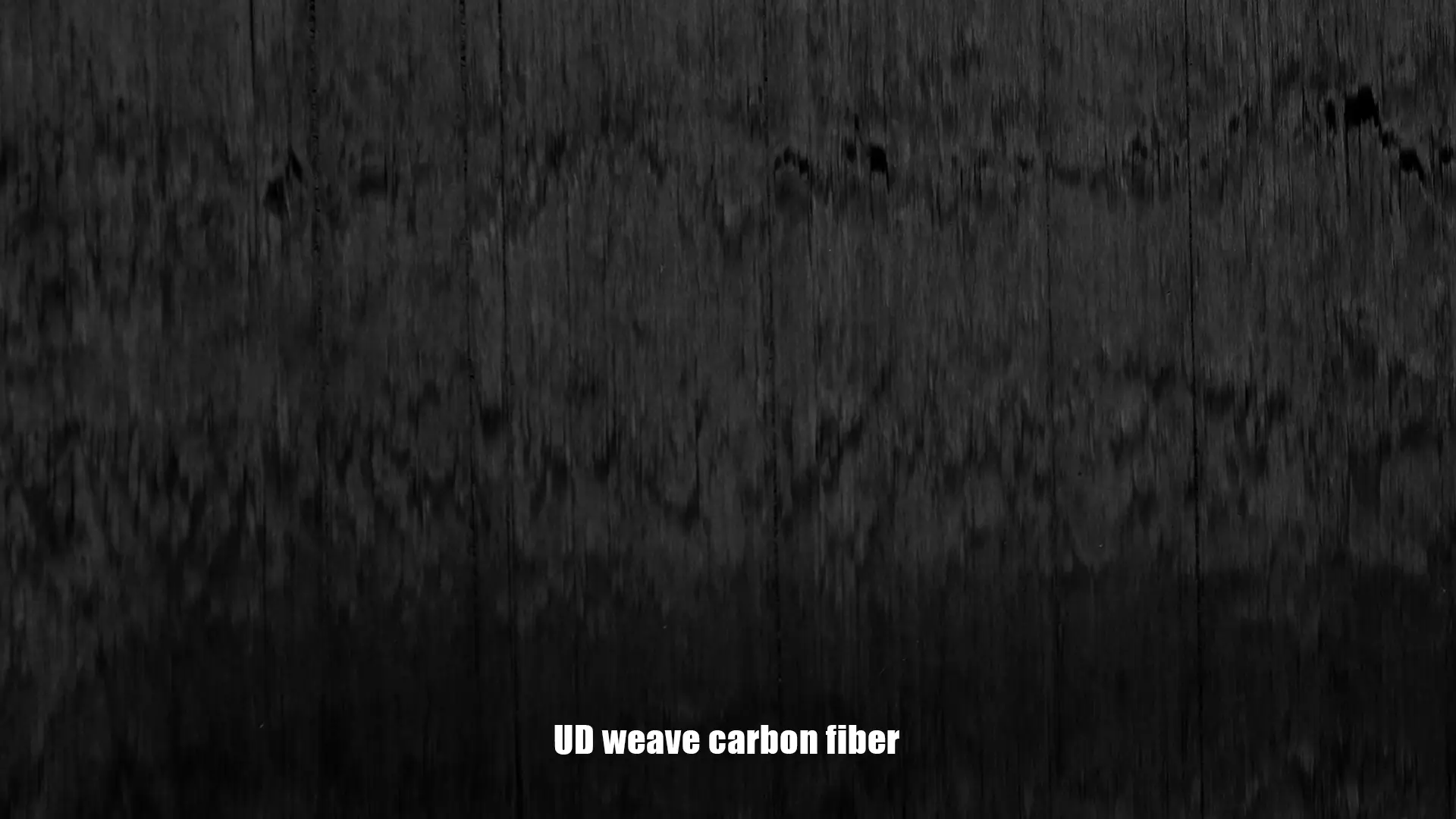
Plain-twill-Satin-UD weave Carbon Fiber Comparison
| Feature | Plain Weave Carbon Fiber | Twill Weave Carbon Fiber | Satin Weave Carbon Fiber | Unidirectional (UD) Carbon Fiber |
|---|---|---|---|---|
| Visual Appearance | Grid/Checkerboard Pattern | Twill Weave, Smooth Appearance | Soft, Glossy, High-End Look | Linear, Simple Parallel Fiber Lines |
| Flexibility | Less Flexible | More Flexible | More Flexible than Plain Weave | Highly Flexible in One Direction |
| Drapeability | Not suitable for complex curves | Ideal for curves and corners | Excellent drapability, smoother drape | Minimal drape, best for flat surfaces |
| Strength Distribution | Even, Slightly Stiff | Best for Multi-Directional Loads | Even, Good for Surface Aesthetics | Strongest in One Direction, Weak in Others |
| Surface Smoothness | Rougher Surface | Smoother than Plain Weave | Very Smooth, Luxurious Feel | Smooth Surface, Limited Texture |
| Resin Flow During Lamination | Slower Resin Flow | Better Resin Flow | Excellent Resin Flow | Excellent Resin Flow, Minimal Wastage |
| Common Uses | Flat Panels, Structural Plates | Automotive Parts, Sporting Gear | High-End Consumer Products, Luxury Applications | Aerospace, High-Performance Parts |
| Price Difference | Typically Lower Cost | Slightly More Expensive | More Expensive due to Aesthetics | Usually More Expensive Due to Performance |
| Special Notes | Good for rigid structures | More versatile for complex geometries | Premium look, used in high-end finishes | High strength in one direction, used where unidirectional strength is needed |
Factors to Consider When Choosing Carbon Fiber Weave
- Application Type
Ask yourself: Is this part meant for structural use or visual enhancement? Custom plain weave carbon fiber suits structural use, while custom twill weave carbon fiber is excellent for aesthetics. For parts that require high strength and performance, plain weave or UD fabric may be the better choice, while twill and 5HS are ideal for more aesthetic applications. - Shape and Moldability
More complex shapes benefit from weaves like twill or satin, which offer greater drape. If the part is flat or gently contoured, plain weave may be sufficient. UD fabric is particularly useful when the part needs to be oriented in one direction but must also be combined with other weaves for stability. - Surface Finish
Twill and satin weaves provide smoother finishes, which is ideal for visible parts in luxury or consumer products. If your project requires a glossy and smooth finish, consider opting for a twill or 5HS weave. - Load Direction
If the part needs to resist forces primarily in one direction, incorporating unidirectional fabric is effective. UD fabric is specifically designed to handle load in one direction, so it is commonly used in load-bearing applications like bike frames and performance car parts. - Custom Layup Options
Custom combinations are possible. For example, you might layer plain weave for stability with a final top layer of twill for aesthetics. Hybrid layups can combine the best properties of each weave to meet specific functional and visual requirements.
Professional Recommendations
For most custom applications:
- Use plain weave carbon fiber when strength and stability are critical.
- Choose twill weave for a balance of beauty and flexibility.
- Opt for 5HS for elegant, complex designs in aerospace or high-end consumer goods.
- Integrate UD fabric for strategic reinforcement.
We often recommend hybrid layering to combine the best of each weave’s properties. For instance, layering UD fabric with a top layer of twill can provide superior performance and aesthetics in automotive or sporting goods applications.
Customer FAQs About carbon fiber Weave
1. Which is stronger, twill or plain carbon fiber?
Both offer excellent strength, but plain weave is slightly stiffer, while twill offers better flexibility and drape.
2. Can I use both twill and plain weave in one custom carbon fiber part?
Yes. Hybrid layups are common. Twill for outer layers, plain weave for internal reinforcement.
3. Does weave pattern affect weight?
Not significantly. Tow size and fiber content play a bigger role in weight than weave pattern.
4. Is twill weave better for visible surfaces?
Yes. Twill’s flowing texture is preferred for aesthetics in visible parts like car exteriors.
5. Which is easier to machine?
Plain weave is stiffer and more stable, making it slightly easier to CNC machine for flat parts.
Final Thoughts
As composite material experts, we are willing to provide you with critical assistance. The correct judgment now avoids cost overruns, delays, and disappointing results later.
Need advice on your custom carbon fiber part? Reach out to our team for expert guidance.
